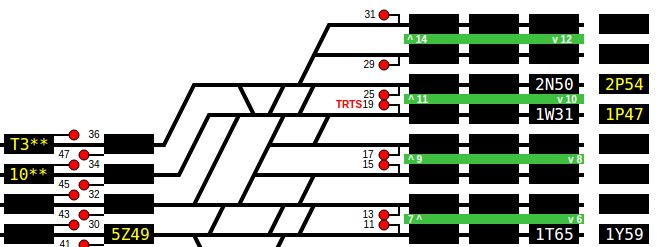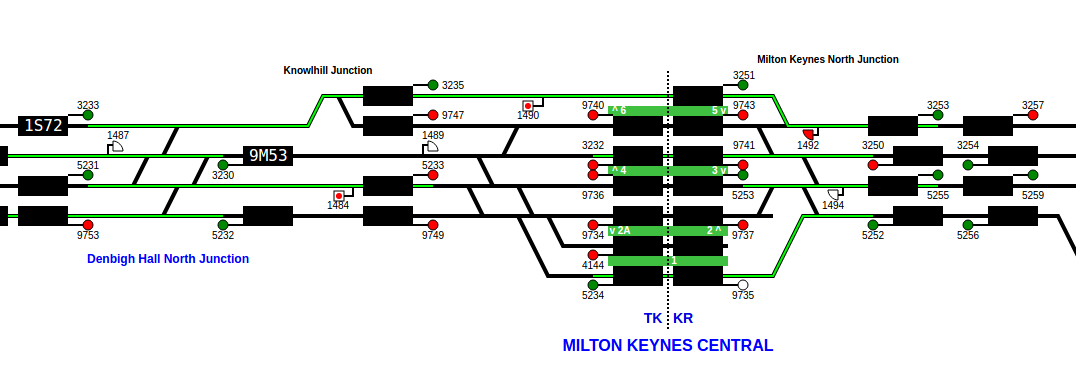About the live track diagrams
Our live track diagrams show you trains moving in real-time. They're fed from equipment at signalling centres all over the country.
Train reporting numbers
Each train schedule has a four character code called the train reporting number assigned. This code, sometimes called a headcode, is entered in to the signalling system at the start of a train's journey, and is called the train description.
Moving between signals
Each time the train moves past a signal, the train description is automatically moved from one berth to another. Berths are shown on our diagrams as black rectangles. A description in a berth will show up as text - for example, 1N01, and you can click on many of them in white to show the train schedule. Be warned: the way we've done this isn't 100% accuarate, and we're actively working on a better way.
Special cases
Berths can also contain descriptions which are not trains. Berths which contain the non-described special description (****, or *X** on much of the former Southern region) - indicate that a piece of track has been occupied out of sequence. This could be a problem with the train detection equipment, or it could be a train moving in an engineering possession - it's not possible to tell just from looking at the map.
During engineering works, descriptions are used to communicate a variety of scenarios. Here are some of the commonly used ones:
SHUT: The line is shutBLOK: The line is blocked to all trainsBTET: The line is blocked to electric traction (BTET)-T3-: The line is under an engineering possession (T3 is taken from module T3 of the Rule Book)-EO-: The line is under an engineering possession (commonly used on DC-electrified lines in the former Southern Region)ITEM: The line is under an engineering possession (taken from a Weekly Operating Notice (WON) item)POSS: The line is under an engineering possession
There is no standard, only conventions which may be used across several signalling centres.
Clickable links
Where a station or junction label is shown in blue, it may be possible to click or tap the label to bring up trains scheduled to stop or pass that location.
Where a description is in white, our system may have been able to link it to a schedule. Click the description to see the schedule. We are aware that this doesn't work for some parts of the country, and we have a workaround planned.
At the edges of most maps, there will be a box with text such as "To/From Wembley Central". Clicking or tapping on this box will load the adjacent map at the right position to allow you to track a train across maps.
Signal aspects
Many signalling centres transmit information on whether signals are showing their most restrictive aspect (usually a red, danger aspect) or not. Where we receive this information and are able to decode it, we show it against signals. We show a red aspect when the signal is reported to be at danger, and a green aspect in all other situations. On the trackside, the signal may actually be showing a single yellow, double yellow or green aspect.
Depending on the configuration of the signalling system, only some signals in a particular area may have their aspect information transmitted. In older systems, we do not usually receive information about automatic signals - only controlled signals.
Where a signal is shown as a white circle, we do not currently know what aspect the signal is displaying. This may be because the signal isn't used regularly and we've never had information about it.
Route indications
Some signalling centres also transmit information on routes set from signals. We show this on our diagrams as a solid green line against the track, with the line representing the route between a pair of signals. This does not necessarily mean the first signal is showing a proceed aspect - only that the signalling system has reported that the route is set.
Train Ready to Start
At some stations, platform staff can indicate to the signaller that a train is ready to depart using a button or key-switch on the platform. Where we have this information available, we show the letters "TRTS" (for Train Ready To Start) next to the signal.

The example above shows the train at platform 10 at London Paddington being indicated as ready to start. The signaller, or signalling system, may then prepare for departure of the train. If there are gates at the platform or staff at the platform entrance, these may be locked and it might not be permissible to board the train - it depends on the specific situation.
Further examples
Here is a snapshot of Milton Keynes Central station in Buckinghamshire:

There's a lot we can tell from this diagram!
Train 9M53 is approaching signal TK3230. This signal is showing a proceed aspect and is coloured green, and it has a route set toward the next signal.
Train 1S72 is approaching signal TK3233. This signal is showing a proceed aspect and is coloured green, and it has a route set toward TK3235, which means the train can only run in to platform 6 at Milton Keynes Central once it's passed TK3233. If the route was shown to signal TK9747, then the train can only run in to platform 5. These route indications usually appear a minute or two before the train approaches the signal, so you can tell where a train is planned to move next.
Signal KR5252 is showing a proceed aspect with a route set to signal TK5234, which means the next train to pass it will run in to platform 1.
If a train were shown at signal KR9743, it wouldn't be able to move toward signal KR3253, because the route is already set for a train from platform 6. Similarly, the train couldn't also move toward signal KR5255 as a route is set from signal KR3250 to TK3232. Any train at signal KR9743 can therefore not move northbound (toward the right of the diagram) until a route is set and the signal cleared.